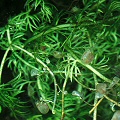Q: About buying purified water.

Utricularia olivacea
A: Have I impressed upon you that carnivorous plants need pure water? Good.
As you decide what kind of water to use, consider the following, please.
It is not easy to grow carnivorous plants. You will make lots of mistakes. So
why not be sure that at least the water you use is pure? If you e-mail me
with a question about your plant, I will assume you are using purified water.
If you are not, then you deserve to have your plant die.
Bad person! Bad person!
Play it safe. Use water purified by either distillation or reverse
osmosis. Once you are really good at growing carnivorous plants, experiment
with other stuff. Use rain water, tap water,
sea water, soda pop, horse urine, whatever---just don't
complain to me when your plants start dying.
Distillation vs. Boiling Water
Distillation is not, absolutely not, the same thing as boiling water, OK?
When you boil water, you raise the water to the boiling point (duh!) and drive some of the
water molecules from the liquid phase (water) into the gas phase (steam). Whatever is left in
the pot---the impurities---are still there. Only now they are dissolved in less water. As a result,
the water is even more impure than before! (Although the bacteria and protozoans harmful to human health
are often killed.)
In distillation, the water is boiled and then the steam is captured. The steam is condensed, and it is
this condensate which is the purified (distilled) water.
Do you see the difference between this and just boiling water?
Reverse Osmosis
Reverse osmosis is a process in which water molecules are forced through a
semipermeable membrane by a pressure differential. Sounds complicated, I know, and
actually it is. It's almost magical! Where's Maxwell's daemon?
The point is that this is like an exceptionally fancy filtration system. The semipermeable membrane, by the way,
is a hi-tech, expensive thingee that costs a couple hundred dollars all by
itself. It is not to be confused with a cheapo pour-through water filter.
Reverse osmosis systems are often called RO units, and the water they make is
often called RO water. Got it?

Utricularia ochroleuca
How to get purified water
You can buy purified water at grocery stores. Look carefully at the label on the bottle.
It must include one of the two magic phrases:
"purified by distillation", or
"purified by reverse osmosis."
It can say other things about carbon
filters or ultra-violet radiation, but those do not count. It must have one of
those two magic phrases. Do not buy stuff called simply
"drinking water." That means nothing, and could just be water
out of someone's toilet (ask any dog). "Spring water" is equally
meaningless.
You can buy water at vending stations. Read the writing on the machine
carefully. Does it say one of the two magic phrases? Also, does it mention
the last time the unit was serviced? Reverse osmosis units should be serviced
at least every six months.
If you get tired of lugging heavy water bottles around town, you may decide to
buy or rent your own water purifier. Most people opt for RO units instead of
distillers.
You can buy one for about $300 or more. I've been noticing that some mega-stores are
stocking ones for about half that, but I don't know if they're any good.
A great route is to
rent one from a national water purification chain. When I maintained a greenhouse of
carnivorous plants, I rented one from a company that I will not name, but for which I
will use the code name "Culligan".
For me, the rental advantage was that the company checked my machine twice a year and replaced
defective or worn out parts. The RO unit I rented had a retail value of about $500, but only
cost about $30 per month to rent.
If you buy your own RO unit, also buy quality equipment to test your
water quality. This equipment may be expensive, but
it is a good buy if you have more than a few hundred bucks invested in your plants.
I test my water quality every six months.
If you buy a cheap RO unit, test the water every three months. Conventional wisdom is that
you want the TDS (total dissolved solids) to be around 50 ppm or
lower.
By the way, some people do not like RO units because they produce a lot of "waste water." That is, for each liter of purified water
produced, you might get two or more gallons of "waste water" that carries away the impurities removed from your
purified "product water." Well, it turns out that RO units are often designed to dump the water into a tank with an
air-filled bladder. This bladder creates a back-pressure, so that when you open up the tap to the tank, your product water flows
out readily. Very nice, but the back-pressure also decreases the efficiency of the RO unit.
If you are happy to simply capture the
product water in an unpressurized tank, the efficiency of the RO unit increases dramatically. You will have very little waste water
indeed.
Page citations: Rice, B.A. 2006a; personal observation.